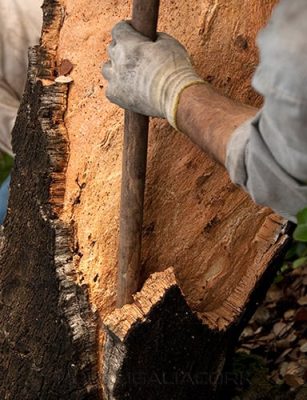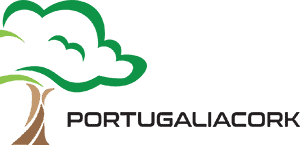Cork harvest
The process of cork extraction commonly referred to as “descortiçamento” is a very skilled task. It’s a carefully laid out procedure, with several steps in which the cork is extracted from the cork tree with a special machete. It has been passed on by generations of men and women specialized in doing this for a living, requiring manual precision and experience.
Cork’s life cycle begins with this extraction process. During the Summer months of May to August, the harvest takes place. These are months where the cork’s growth is at its highest. Although it seems somewhat straightforward, it needs special attention to detail given the tree’s development’s particular requirements.
It takes 25 years until the first cork can be extracted from a Cork tree. Each trunk needs to reach 27,5 inches in diameter and 51 inches of height from the ground level. From this stage onward, the tree can produce cork every nine years for about a century and a half.

3 different stages of cork harvesting
- The first extraction is called desbóia. The cork retrieved from this first strip is irregular, tough, and very difficult to work with. It is also commonly known as virgin cork. It will be used for purposes such as decorative panels, flower pot vases, animal hides and other applications.
After removal, the tree is tagged with the extraction year, so the workers can know when to get back to it to extract more cork. - The second extraction of the cork tree after the first nine years is called secundeira. Although much more malleable and regular than the initially extracted cork, it is still not the highest quality cork.
- The third harvest marks the beginning of the material’s maturity and highest level of quality. From this stage forward, every nine years, the harvested cork is the best quality possible. This is the cork used in the manufacture of the best natural cork stoppers used to age the best wines worldwide. This cork is designated by amadia or reproduction (cork).
Cork sorting
When the cork is harvested, it goes through a final period of rest for stabilization and maturation. Only then it begins a new journey towards manufacturing.
The cork’s current harvesting stage will determine its final destination. Cork from the first and second stripping (virgin and secundeira), and also remainings from the tree’s maintenance, will be used for products other than cork stoppers. This cork is able to be mixed with different ingredients further down the production process, making it extremely diverse.
Although the amadia cork can be used for these products as well, from the third stripping onwards, it is ready to be used in cork stoppers production. Only from the third batch of cork onwards from the same cork tree it can be guaranteed the required quality for this product.







